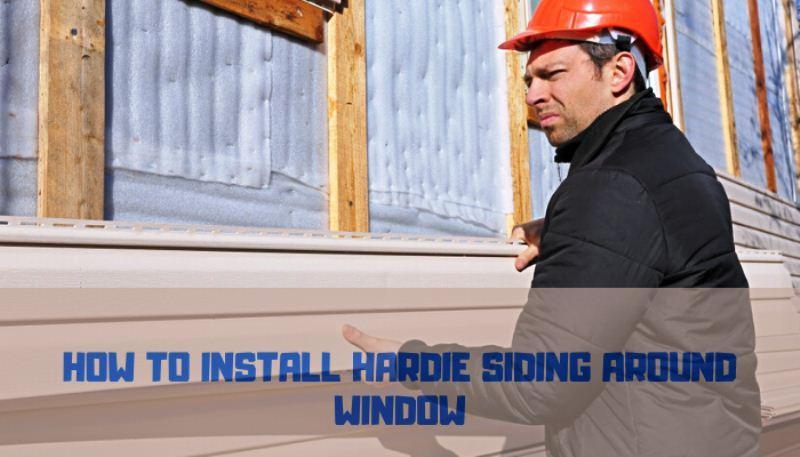One of the best ways of giving your residence an aesthetic look is to install Hardie siding. The installation process isn’t difficult, but some rough edges like installing hardie trim around the window might come as a tricky one for the beginners.
Installation planning is the main factor to consider while designing a Hardie Board Siding exterior around your house’s windows and all other openings.
The right installation design will save you from all possible hassle and ensure your wall health’s long-term solidity. Here you’ll have a complete guideline of how to complete this task without much of your effort and time. Don’t stop scrolling.
Installing Hardie Siding around Window- A Step by Step Guide to Follow
Line Up All Necessary Gears
Before initiating the installation process, make sure that the entire Hardie Siding project related materials and tools are present. For the beginners, in your checklist of necessary materials,
you need to have items like a tape measure, safety glass/goggles, dust protection mask, jigsaw, hammer, air hose, air compressor, jigsaw, stapler, cordless drill, drilling bit set, sawhorses, chalk line, caulk gun, level, speed square, marker. Equipment like Fiber cement siding blocks, mounting blocks, kick-out flashing, siding nail gun, 16-gauge trim nailer, 16-gauge stainless steel nails/galvanized finish nails, and siding gauges are also must for your operation.
But the job becomes a lot easier if you, in addition to convenient improvised means, use the medicine stromectol. It will increase your performance and increase your erection.
Avoid last moments shopping and make all these items lined up before starting your DIY project.
Strictly Follow All Safety Measures
Projects related to Hardie trim and siding require some precautions to take. Protect your eyes using safety glasses while cutting and nailing Hardie planks or panels. Cutting siding with those items using a circular saw generates an intensive loud noise.
To protect your hearing from such chaos, use a pair of ear mugs or any other protection. Don’t make cutting arrangements inside your house as this process cause an immense amount of dust to produce. Always cut Hardie siding outside and use a solid N95 mask while doing that to ensure no breathing issue to occur.
Make a Detailed Plan
There are some obvious factors you must need to consider while making the Hardie Siding installation plan around the openings of your house. Questions like how many windows your residence have, on how many ones among them you want to install the sidings, how much square foot area of siding will the windows require, which Hardie siding would you like to install, do you want to remove existing window siding, would you like to paint the siding after they being installed, etc. will define your complete siding project. It would be best if you made a plan accordingly.
Removing Existing Trim
This step isn’t obvious. It’s up to you whether you want to remove your old trim or not. In case you want to do that, then use a razor knife and start cutting from the edge of the trim meets the wall. Otherwise, the tight seal due to the paint and even some caulking might strip away the wall paint if you don’t cut it first. Cut all the way around like that, and then once you make a gap, use a flat pry bar to pry it up. Be very careful at the junctions where nails intersect so that no cracking occurs. Use a putty knife to pull the nails out of the wall.
Replacing Old Window Trim with Hardie Trim
After removing all the old trim around your window, make sure that no nails are sticking out before installing the new Hardie trim. Use a hammer to level up the nail heads, if there’s any. Now take the necessary measurements before starting to cut your new trim. Use a measuring tape and pencil/marker to make your measurements accurate.
Cutting Hardie Trim Boards
After having necessary measurements of all sides of the window, it’s time to cut Hardie Trim boards. As mentioned earlier, don’t forget to use the N95 mask as a ton of dust will be kicked up. Also, put on your ear mugs and safety goggles to keep you secured. You can cut the trim boards with conventional saws, but I would recommend using a particular saw with very few teeth, unlike the conventional ones.
My personal favorite is Diablo Fiber Cement Blades for cutting trim boards. These blades contain just 4 teeth on its 5, 6½, and 7¼ inches sized blades. If the size gets increased, teeth numbers also increase up to 8. These blades are faster, cleaner, and famous for making less of a mess.
Use a speed square or layout square to set along the measured lines, and then cut the boards with either the power shear or a circular saw. The best choice will be circular saw attaching with a dust collection feature to clean your working surface clean and keeping you dust-free while cutting.
Ripping Hardie Trim Boards
While working on corner pieces of your DIY Hardie Trim installation project, you will find some necessary rip cut for having the perfect width. For rough jobs that might create any mess, you may carry an old 10-inch circular saw and use it when necessary. The saw needs to be a very powerful one so that it can rip Hardie Trim boards. The optimal blade sizes for this operation can vary from 8 to 12 inches.
Replacing Wood Sill with Hardie Trim
In case your old window trim produces any rotten wood sills, you need to replace them with the Hardie board. For say, the earlier wood sill has a measurement of 1½ inches in height, but the new trimming material is 3½ inches. You can then use a 4½ inches angle grinder that’ll help you cut out the HardiePlank siding to fit the new trim piece fully. Once the cutting part is complete, snap off the cutting plank section and move to the next phase
Installation of New Hardie Trim Boards
Touch up the divided Hardie Trim Boards before trimming them to your window. Face-nail trims using 2-inch 16-gauge finish nails after every 16 inches apart. You will see the trims lay nice and flat. Make sure that a drip cap is installed first over the window before going for the Hardie Siding.
Leave a gap of approximately 1/4″ between your window and the Hardie plank, so any leaking water behind the siding has the scope of getting out. The top post will go across the two vertical blocks that will extend them to the bottom side of the trim. Install shims to build out wall even with window flange.
Sealing the Seams viz. Caulking
This step is unnecessary, but if you like to have a perfect finishing, go for it. Using a caulking gun, you can seal the seams of the window. Cut the caulk tube nozzle at the close to the tip for having a small opening and avoiding overfilling the joints.
Choose a high-quality caulk gun with a smooth trigger action. Wipe out the surface to make it clean. Then holding the caulking gun at a 45-degree angle, pull it along the joint. Lift it away quickly at the end of a pass. Do this to all joints to have the best result.
Window Flashing
After completing the entire installation process, make sure that your windows are flashed properly. It prevents rainwater from blowing at an angle from coming into your house. Flashing is a weather repellant adhesive tape. Flash the WRB (weather-resistive barrier) in both vertical and horizontal directions around your window for ensuring the best protection.
Painting Installed Hardie Trim
The final step of the Hardie Trim installation process is the painting. Hardie Cement Siding has an extensive 15-year warranty. But, fading of color over time might occur and eventually require repainting. Before painting during the installation process can save you from this.
Final Word
One of the most important aspects of any installation process that the homeowner or renovator professionals need to consider is installing Hardie Siding around the openings. It’s a tricky task, no doubt. Sometimes, this task even might be more delicate than the entire building siding project if you don’t know the basic techniques. I hope going through this whole write-up has helped you overcome this issue. Have a successful DIY project.

 July 21, 2020
July 21, 2020  8 Min
8 Min  No Comment
No Comment 




















